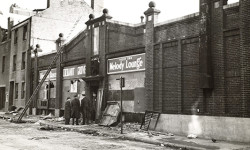By Bill Lombardi
Hometown Weekly Correspondent
November 7, 1916 was one of the most exciting election days in the history of the country, and one of the most tragic in the City of Boston.
President Woodrow Wilson was challenged intensely by his opponent, Charles Evans Hughes, and the general feeling was that he would not be re-elected. In Massachusetts, a tremendous baffle for U.S. Senator was being waged between Henry Cabot Lodge and John “Honey” Fitzgerald.
November 7 was a warm night. It was about 5 o’clock when Gerald Walsh pulled street car #393 out of the City Point car barn in South Boston. This was rush hour, when workers were going home for the day and the main topic of discussion was the election.
The passengers had no idea of the fate that awaited them.
The streetcar was slowly approaching the Fort Point Channel Bridge on Summer Street. Meanwhile, Tim Shea, the attendant, got the signal to open the drawbridge to let a tugboat through. He hung up two red lanterns and closed the gates.
He then heard an on coming streetcar and looked on in horror; he could see it wasn’t going to stop in time.
 Inside the overcrowded streetcar, Walsh was desperately trying to stop. He claimed later that the brakes would not hold. Then, WHAM! The trolley crashed through the iron gates and sailed off into open space. Passengers standing in the rear jumped off and landed in the water. The trolley flooded rapidly and sank 24 feet below the surface. The few passengers who managed to squeeze out the window later said that a people were scratching and fighting madly to get out of the doomed car.
Inside the overcrowded streetcar, Walsh was desperately trying to stop. He claimed later that the brakes would not hold. Then, WHAM! The trolley crashed through the iron gates and sailed off into open space. Passengers standing in the rear jumped off and landed in the water. The trolley flooded rapidly and sank 24 feet below the surface. The few passengers who managed to squeeze out the window later said that a people were scratching and fighting madly to get out of the doomed car.
Nelson McFarland, a 23 year-old passenger from Dorchester, a strong swimmer, had a terrifying experience. He was well into the car when it hit the bottom of the channel. He saved some lives by pushing them through an opening in the trolley. Bodies were moving frantically all around him. The mud from the impact of the trolley caused the water to become murky and visibility was very poor. Nelson, now completely exhausted, had to find a way out to save himself. Miraculously, with all the kicking and shoving, he was pushed through an opening and swam to safety.
In a short while, rescue crews and divers arrived on the scene. Hundreds of people stood on the bridge watching as search lights lit up the dark waters. Divers sent down to the trolley said it was a horrible sight. Heads, arms and legs were protruding through the broken glass windows. The crowds grew larger and panic set in as they surged forward to get a glimpse of the bodies being raised and put on the police boats. One diver almost suffocated when he got tangled in the lines. A Navy derrick was used to pull the trolley up from the water. All the bodies were taken to a mortuary where they were claimed by their next of kin.
When the day was over, the final result showed that Woodrow Wilson had just barely won re election as president. In Massachusetts, Henry Cabot Lodge edged out “Honey” Fitzgerald in a close baffle.
In the city of Boston, 46 people had perished in a trolley that fell into the ocean.
Although there was a shortage of trolley cars, it seemed incredible that car #393 was put back into service with its original number. It was often referred to as the “death car” or the “ghost car.” Some people were actually afraid to board it. For the families and friends of the victims, it must have been an eerie feeling to see car #393 go by.
After seven months and much controversy, car #393 was taken out of operation.
Gerald Walsh never drove a street car again. He found employment elsewhere. When World War I broke out, he enlisted into the army, went overseas to war, and came home a decorated soldier. Walsh’s life was never the same after the accident. For the rest of his life, he suffered from depression. He died at the age of 43 of a heart attack at his South Boston home. Nelson McFarland became a wealthy business. He died at the age of 57.
One off the biggest mysteries at the time was what had happened to Elsie Wood. Elsie was a beautiful 19 year-old stenographer known to be on the streetcar. Those that survived said they remembered seeing her just before the accident. Her ID bracelet was found in the car, but her body was never recovered. The most logical conclusion at that time was somehow she managed to get out of the trolley, but drowned and was carried out to sea.
Six months later, in May, a young girl’s body that washed ashore was identified as Elsie Wood.
Bill Lombardi is a U.S. Marine Corps veteran. He is the grandfather of Emily, Ashley and Zachary Sullivan, and Cayce and Jimmy Lombardi - all Walpole residents.






















